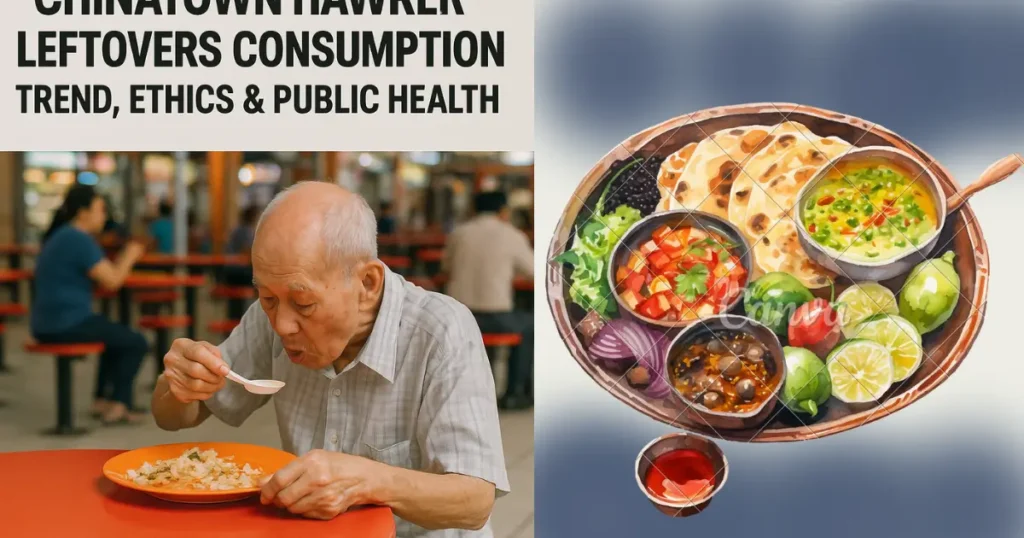
In bustling Chinatown Hawker Leftovers Consumption around the world, hawker centers are famous for their affordability, cultural richness, and culinary variety. But a controversial and growing trend around these food hubs has emerged—the consumption of hawker center leftovers.
From food security seekers to zero-waste advocates, many individuals are gathering or consuming uneaten food from trays, tables, and even bins. This behavior raises a mix of public health, ethical, and sustainability-related questions, especially in food-conscious countries like Singapore, Malaysia, and Hong Kong.
This article explores the rising discussion around ‘Chinatown hawker leftovers consumption’—its causes, cultural context, health concerns, and global reaction.
Why Are Some People Consuming Hawker Center Leftovers?
1. Rising Cost of Living
In cities like Singapore, Kuala Lumpur, and San Francisco, inflation and economic hardship have driven some individuals to seek alternative food sources—even if unconventional. Eating leftovers from public spaces is sometimes seen as a way out of urban food insecurity.
2. Minimizing Food Waste
Environmental and zero-waste communities argue that untouched leftovers shouldn’t go to waste, especially in societies where 3,000+ tons of food waste is generated daily (Singapore example). In this light, some groups promote “food rescue” as part of sustainable urban living.
3. Cultural & Spiritual Beliefs
In some Asian healing traditions and Buddhist practices, wasting food is discouraged. Some individuals act on conscience or belief, believing in “not letting karma go to waste,” making it a moral rather than nutritional decision.
Health and Hygiene Concerns
While well-meaning, consumption of hawker leftovers brings risk of foodborne illness, cross-contamination, or exposure to pathogens.
Risks Include:
- Bacillus cereus, E. coli, and Salmonella
- Contaminated shared table surfaces
- Food left out beyond safe temperature windows
- Improperly discarded or half-eaten items
Public health authorities warn strongly against this behavior, citing risks especially for the elderly, children, and immunocompromised individuals.
Viral Incidents: Social Media Spotlight
In 2023 and 2024, videos surfaced on TikTok, YouTube, and Weibo showing individuals in Singapore’s Chinatown Complex and Maxwell Food Centre picking up untouched food from hawker trays. These sparked both outrage and sympathy:
- Netizens expressed concern for hygiene laws
- Others pointed to homelessness and food costs
- NGOs began forums on food accessibility and stigma
The keyword “Chinatown hawker leftovers consumption” started trending across Reddit, news outlets, and international Google searches.
Government & Community Response
Governments across Asia have taken notice. Initiatives include:
- Singapore NEA’s Anti-Scavenging Legislation: Eating discarded food in hawker centers is considered illegal under public nuisance laws.
- Hawker Centre Donation Channels: Leftover food from certain vendors may now go to licensed food charities.
- “Clean Table Campaigns”: Encouraging diners to return trays quickly unopened to minimize food waste and discourage public scavenging.
Ethical Conversations on Food Waste
This phenomenon also opens up a larger ethical debate:
| Argument For | Argument Against |
|---|---|
| Reduces food wastage | Breaches public hygiene codes |
| Accessible food for poor | Encourages risky behavior |
| Cultural views on karma | Normalizes scavenging in modern society |
The conversation touches on sustainability vs dignity, legality vs ethics, cleanliness vs conscience.
Global Implications: Beyond Chinatown
This trend isn’t limited to Asian cities. Similar behaviors have occurred:
- 🗽 New York City: Reports of dumpster diving have increased among students
- 🇬🇧 London’s Borough Markets: “Food waste warriors” collect leftovers nightly
- 🇩🇪 Berlin’s Containern Activists: Push for food rescue law reform
While the Chinatown hawker leftover consumption topic is local in origin, it’s being echoed in global urban survival strategies and sustainable dining debates.
SEO Keywords & Semantic Variants Used:
- hawker center leftover food
- food waste in Chinatown
- Singapore street food scavenging
- public food safety policies
- urban food insecurity
- eat from hawker center trays
- zero waste dining Asia
- scavenging vs sustainability
- social trends in food reuse
What Can Be Done?
To prevent both waste and public health risks, solutions may include:
- Transparent food donation funnel systems within hawker stalls
- Public education campaigns around food rescue do’s and don’ts
- NGOs partnering with stall owners for orchestrated food redirection programs
- Encouraging clean, safe urban food recycling initiatives
Conclusion: Balancing Compassion, Cleanliness & Culture
The conversation around Chinatown hawker leftovers consumption opens our eyes to the human side of food waste, poverty, and policy. While the impulse to not waste food is relatable, it must be balanced with public health priorities.
As cities grow more expensive and people more conscious about sustainability, this controversial practice forces governments, businesses, and individuals to ask tough questions:
- How can we waste less while still ensuring safety?
- Is there a middle ground for dignity and hygiene?
- What food system changes do communities truly need?
Key Takeaways:
- Rising issue in hawker centers in places like Singapore & Malaysia
- Triggered by economic hardship, sustainability movements, and cultural beliefs
- Serious health risks involved with leftover consumption
- Viral videos and public reactions put pressure on authorities
- Ethical implications touch every layer of society—from food security to personal choices
Final Thoughts: A Global Trend to Watch
Whether you’re on the side of sustainability or sanitation, Chinatown hawker leftovers consumption is a defining case study in modern food ethics. As cities transition into smarter, more sustainable futures, so must our systems around how food ends up on a plate—or not.






